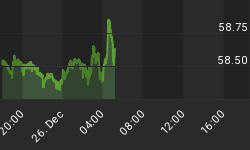The CPBE Options Equity Put/Call Ratio Index is shown below, with the S&P 500 Index shown in the background in black and accompanying stochastics shown below. For this chart the %K above the %D for a given stochastic is an indication of general weakness in the broad stock market indices, while falling beneath the %D is an indication of general strength. At present, the %K is above the %D, indicating market weakness and was running at a divergence to the S&P 500 Index that was grinding higher. The S&P 500 Index broke 925 as mentioned last week and is likely to at least take a trip to the 850-870 area...if a summer rally is to occur for July and into August, the S&P must bounce off this region and grind higher, otherwise it could continue to slip lower. Anyone trading this decline should be aware of the above possibilities.
Figure 1
![]() Larger Image
Larger Image
The daily chart of the S&P 500 Index is shown below, with an alternate Elliott Wave count shown below...if this count were to hold true a sharp down leg should initiate anytime (I put a lower degree of confidence into this count, but it is a possibility. Full stochastics 1, 2 and 3 are shown below in order of descent, with the %K beneath the %D in stochastics 1 and 3. Although it is probable a top has been put in place, the sideways action of stochastics 1 and 2 the past two months requires a definitive breakdown of the %K in order to conclude that a topping pattern is complete. Based upon this chart, this chart has a neutral to slightly negative bias. Anyone shorting should use tight stops in the event the S&P swings higher.
Figure 2
![]() Larger Image
Larger Image
The weekly chart of the S&P 500 Index is shown below, with upper 21 and 34 MA Bollinger bands nearing the index, while the lower 34 MA BB has popped above the 21 MA BB, indicating the mid-term trend is oversold. Full stochastics 1, 2 and 3 are shown below in order of descent, with the %K above the %D in all three instances. The weekly chart remains positive, although it should be pointed out adding to long positions at this juncture is not recommended. The %K in stochastic 1 is near the top of the range, while it has yet to cross above the 50 level in stochastic 2. My read on this pattern is that the S&P is in a decline sequence and has the potential to turn higher...but it could keep on trucking south if market conditions fall apart, thereby causing a sharp reversal in stochastic patterns. Major declines have been associated with the %K of stochastic 1 falling beneath the %D, so it is probable the S&P continues to put in a topping pattern for another 1-2 weeks. I want to stress that this thought is based upon stochastic positioning and if the %K in stochastic 1 immediately curls down, then chances are a top has been put in place.
Figure 2
![]() Larger Image
Larger Image
The monthly chart of the S&P 500 Index is shown below, with all stochastics falling beneath the index, while upper Bollinger bands continue to drift higher, suggestive that a bottom has yet to be put in place. Full stochastics, 1, 2 and 3 are shown below in order of descent, with the %K beneath the %D in all three instances. Based upon positioning of the %K in stochastics 2 and 3, a bottom in the S&P should not be expected until late 2009/early 2010.
Figure 4
![]() Larger Image
Larger Image
The short-term Elliott Wave count of the S&P 500 Index is shown below. Wave v completed and the S&P either has put in a top and is heading lower over the course of the next few months; or it finds a bottom somewhere between 850-870 and manages to swing up one move time into late summer before topping out. Due to the complexity of the chart below, there are a few other ways to label the pattern if an extension does occur, so I have avoided adding any other labels below Minor Degree (pink) to prevent any confusion. Based upon this chart, the S&P should head below 900 over the course of the next 5-7 trading days.
Figure 5
![]() Larger Image
Larger Image
The mid-term Elliott Wave count of the S&P 500 Index is shown below, with the thought pattern forming denoted in green (added a few months ago). If the pattern does play out, then a decline to 850-870 should occur, followed by a reversal to at least retest the 950 area. It is important to note that failure for the 850 level to hold will imply further downside in the index.
Figure 6
![]() Larger Image
Larger Image
The long-term Elliott Wave count of the S&P 500 Index is shown below, with the thought pattern forming denoted in green. Whenever the pattern is complete, expect the S&P to head lower.
Figure 7
![]() Larger Image
Larger Image
That is all for today...back tomorrow AM.















